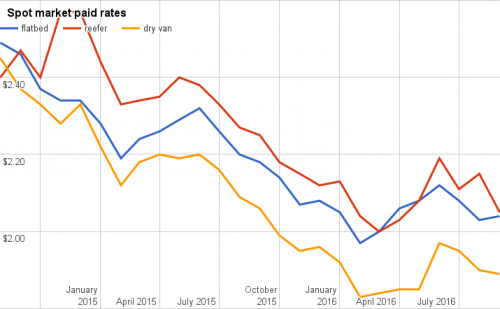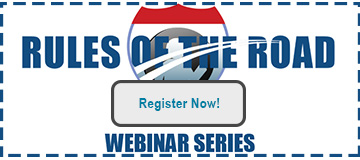
How Small Motor Carriers are handling the current Business Environment
posted in Blog by Brian Gray
How Small Motor Carriers are handling the current Business Environment
In the last 12 months, the trucking industry has seen some major regulatory changes during a slow recovery out of the Great Recession. Motor carriers are facing new regulatory rules covering hours of service, speed limiters, sleep apnea, safety fitness determination, drug and alcohol clearing house, emission regulations, ELDs, and more. Motor carriers need to factor all these changes into daily fleet operations.
Large fleets can handle the ebbs and flows of major regulations easier than their smaller counterparts. Small motor carriers and owner-operators, on the other hand, are struggling. We sit down with one small motor carrier, Joe Ammons of Admiral’s Freight Service, and discuss how they are handling this new trucking environment.
Conversation with Ryan Walsh, Business Development Manager of Glostone Trucking Solutions and Joe Ammons of Admiral’s Freight Service:
1. How long have you been in trucking and how long have you been an owner-operator?
Joe Ammons: I started driving in 1976. I took a 10 year break between 1985-1995 for college and a try at video production. Then, in 1982, I bought my first truck and lost my shirt. In 1999, I bought my second truck and have been an O/O since.
2. How, if at all, have you seen your freight rates change over the past 18 months?
Joe Ammons: Rates have been in decline the last 18 months.
In fact, according to CCJ, “per-mile rates on the spot market remain well below levels seen in 2014 and 2015, as diesel press fell off and freight slowed down late last year.”

3. How much leverage and flexibility do you have, and have you had, in negotiating your freight rates during this time?
Joe Ammons: I am leased to Admiral Merchants Motor Freight, and am free to seek freight from their agents or outside 3PL’s and brokers. It is my experience that most of these outside providers will hit you with their “lowest rate”, it is up to me as the service provider to ask for more or decline. In most cases the freight brokers have a little room, and it is up to me to sell my experience, safety record, and availability in order to get my price. For the most part, that has been working to keep rates above my minimum.
4. What are three (3) pieces of advice you could give for dealing with 3PLs and brokers when negotiating compensation for a load?
Joe Ammons: The 3 items I just mentioned: experience, safety record, and availability. Those are the key items I use to negotiate with.
5. How can an owner-operator sell themselves over a larger carrier, especially the “mega” carriers who can offer substantially cheaper rates due to their volume?
Joe Ammons: I try to avoid sarcasms like “you get what you pay for”, or arguing, although I am not afraid to mention deadhead if I have to drive a ways to get their load covered for them. I think the best way to “sell” yourself is being personable with logistics agent. Then they know you will treat their customer right. A small carrier may even mention that you realize that service is all we have to offer over another carrier.
6. If there’s one thing you could change about conventional business practices between owner-operators or small motor carriers and brokers or 3PLs, what would it be?
Joe Ammons: Let them know you will respect their customer, so that the shipper will return to the broker/3PL.
7. We know that average rates of compensation per mile differ regionally, but do you think an owner-operator or small carrier can run a successful business from anywhere in the country?
Joe Ammons: I believe a competent owner can. A small carrier must realize their cost per mile, their fixed cost if you sit too long, and the breakeven of deadheading to a better freight lane rather than taking freight that actually costs you money to haul.
8. When’s the time to stop being a company driver and lease-on or become an owner-operator?
Joe Ammons: I will give you the same answer I give people on the road. You need to have 20% down for your equipment and still have $5-$10K in the bank to cover “short” weeks and breakdowns. Even new trucks have problems, and warranty doesn’t pay the bills. If you can do that and have the right work ethic, you can make it even in today’s market. Just remember you are not going to get rich. All you should expect is good driver wages after cost.
9. Is there anything else you’d like to say about the industry right now, especially regarding best business practices or strategies for financial success as an owner-operator or small motor carrier?
Joe Ammons: Currently it is difficult as a business person to see some of the less than honorable a practices of some of the larger 3pls. In recent months, I have seen companies I thought were admirable doing some “gouging”, particularly on government loads. Taking 48-55% of the bid rate for themselves and then telling the owner-operator “rates are depressed, that is the best we could get” only to have a GBL prove them a liar. Most times in the past we (O/O’s) have taken loads at a quoted rate thinking that the rates are down, but with some of the greatly increased profits of some 3PL companies all at the same time, we are told the rates are depressed and the shippers are not offering more. It really makes you wonder… who is controlling the spot market.
10. Lastly, are you one of the companies who have not yet begun ELD implementation? If so, why?
Joe Ammons: I am leased to a non-asset carrier. We are beginning implementation now, with full operation expected by March or April 2017. It is challenging for the IT department and I know it will require re-training freight coordinators. The real challenge is going to be teaching our agents what this means: advance bookings, stronger detention criteria, and watching inbound board to be ready to offer loads prior to arrival. Then there will be the issue with owner-operators. Some will walk away before signing on to ELD’S is only part of the story. Retention will be a challenge between now and 6 months after full implementation. A lot of the O/O’s here are not accustomed to pre-planning the way it will need to happen. This is every small fleet’s dilemma.








